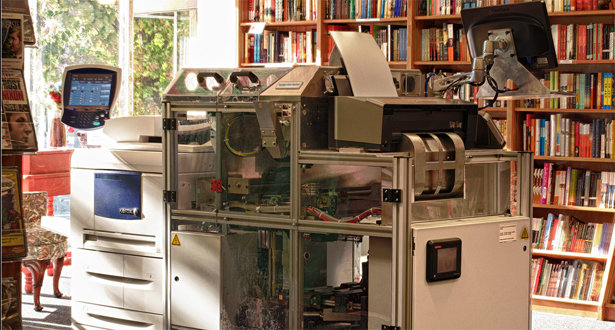PUBLISHED JULY 2017
by Peter Goodman, Publisher, Stone Bridge Press --

Peter Goodman
I read recently in
Business Insider that Amazon’s strategy for making its brick-and-mortar stores successful hinged on three factors: exploiting big data to tailor the store’s offerings to its local demographic; reducing inventory to only a few thousand titles of proven sales potential; and adding a generous mix of non-book products to broaden shelf interest and boost revenue.
There is nothing revolutionary about what Amazon is doing here. Strategies like Amazon’s are exactly what feisty independent booksellers have been using for years to survive the onslaught of big boxes, high rents, and even Amazon itself. Though they may lack the mega-data that Amazon collects from its vast online sales records, indie bookstores do collect data, are locally owned, and, thus, locally knowledgeable. Indie bookstores have also reduced and tightly curated inventory as they shrink their square footage to lower rents. And, for many years, indies have been selling sidelines, including journals, used books, cards, book lights, puzzles, and other items.
But now that Amazon is adopting these exact same strategies in its own retail spaces, what will save the indie bookstore in the future? Is customers’ loyal rejection of big, bad, corporate Amazon enough? Sure, some percentage of book buyers will always favor their local retailers over outsiders, but if Amazon rolls into America’s top book-buying communities with dozens more shops featuring computer-designed inventories, low prices, and lots of shiny objects to fascinate their customers, the ability of indie booksellers to compete will be seriously eroded.
There is one resource that remains almost entirely undiscovered by indie booksellers, and that might be the key to their long-term survival, if not a revolution in bookselling itself. And that is
the hundreds of thousands of books published each year by small independent presses and self-publishers. Currently, these books are almost completely shut out of the brick-and-mortar retail environment. Why? Because the American publishing industry is governed by antiquated systems that were established long before the digital revolution.
To reach bookstores today, books must be printed, shipped to a distributor, and shipped again to a retailer. If sold within a week or two, great; if not, the books will sit on a shelf in the bookstore, taking up valuable space, and producing nothing. If the book sits too long, it gets returned—more fuel, time, and chargebacks to both the retailer and the publisher. Then the book might be too shopworn and subsequently be destroyed, or it may sit at the distributor until the whole process starts again.
We all know how wasteful this cycle is. We all—and I mean all of us in every segment of the industry (except the printers and truck drivers, perhaps)—complain about it.
One negative feature of this system is that very small publishers and self-publishers don’t even have a chance to participate in it. Bookstores generally won’t stock their books because they’re not available from distributors due to their being one-off titles or because their publishers/authors are too small, unknown, lack clout, whatever. There are, in fact, many perfectly good reasons that these books don’t get into bookstores. It’s not that bookstores are ignorant, uncaring, or don’t want them—after all, many of these books are as substantive and well-designed as anything from the Big 5. Booksellers don’t sell these books because it doesn’t make financial sense to even try to sell them. The only way authors can get into some stores is on consignment, but this is obviously not a strategy for broad distribution.
Maybe these publishers should count their blessings that they have avoided the whole wasteful ship-and-return cycle. But the absence of indie books in local bookstores is in every sense a bad thing. It deprives the public of choice. It deprives the publishers of sources of revenue. And, most galling of all, it keeps all the control in the hands of Amazon. Currently, readers who want to find self-published titles have to go to Amazon. And now that Amazon is going local and using the very same strategies as indie booksellers, what is there left to distinguish local booksellers, aside from the fact that they are “not Amazon”?
What if there was a way to make all these hundreds of thousands of books available in the local bookshop?
I think there is. I call it IndieBook. I know my concept is not shovel-ready, but I offer it here as a “thought experiment” for a possible vision of a new future in which book publishers and booksellers can truly support each other and break free of antiquated systems of mutual obstruction.
IndieBook, simply put, is a brick-and-mortar retail environment where real indie booksellers sell real indie books. Not just books from small publishers already served by Consortium, IPG, Midpoint, PGW, and IPS, but books from publishers of every size and scale.
1. The IndieBook physical retail space is community- and consumer-driven, laser-focused on local interests as informed by the knowledgeable store owner and by the store’s exploitation of big data.
Customers in the local area have personalized store accounts that they can log in to at home, or at the store itself. Customers use their account to indicate interest areas, check out new offerings, order books (or e-books or other content), RSVP to events, receive promotion codes, and so on. Many indie bookstores may already be doing this, but these IndieBook personalization systems need to be extremely robust, up to date, and networked in to the store’s own database.
2. IndieBook is 100-percent wired, filled with high-touch kiosks.
Some kiosks are for customers to log in to and service their accounts and preferences; others are dynamically curated by booksellers with up-to-minute listings, tie-ins to whatever is happening in the news, whatever band is playing in town, or backgrounders on important environmental or political issues that everyone is talking about. Large, brilliant color screens serve up covers, snippets, and videos with a “buy” button at the end.
3. IndieBook depends on print on demand (POD), the only sustainable technology that makes sense for small-scale indie publishers and self-publishers.
POD reduces risk at the same it expands inventory a thousand-fold. Readers today already can order POD books printed at Lightning Source or CreateSpace, and they can do that at home on Amazon. But I’m talking about stores using devices like the Espresso Book Machine (EBM), which can turn out a finished book on-site for instant gratification (five to eight minutes). A reader can browse their account at home, find the book they want (an obscure title but one that has just been recommended by their favorite blogger), hit the buy button, and, by the time they get to the store, it’s there, ready for pickup. Or pick your own dreamy scenario of how you can unite readers with the indie books they want in a way that none of your competitors can—and deliver them the same day.

An Espresso Book Machine (EBM) at the Brooklyn Public Library.
I’m aware that the current version of the EBM needs work, but if publishing thinks of this as its moonshot, then reliability, speed, flexibility, and cost can all be improved over time. (And there are delicious possibilities. For example, an entrepreneur could set up an EBM hub with deliveries three times a day in a metro area, providing almost just-in-time service but at a cost shared with several retailers at once.)
4. IndieBook is multimedia.
It provides access not just to books, but to e-books, magazines, granular assemblies of cookbooks and guidebooks, movies, music, personal screeds, whatever content the consumer wants—all available for immediate download or print. Reading is not dying, but reading habits are changing. Booksellers must be content providers first, and find those alternative media and sidelines that serve the reading habit, regardless of medium or format.
5. IndieBook is participatory.
The store must be a gathering place for happenings, tastings, workshops, panels, and community actions that provide helpful information and content in a thoughtful, long-form way. Is there a hot-button issue in town? Load an LED kiosk with relevant front- and backlist titles from publishers large and small. Let local writers print up custom copies of their memoirs, cookbooks, and first drafts. Use the EBM to create personalized copies of books at author signings. Indie bookstores are already masters at this sort of thing. But now they can do it with store inventory, on demand and up to the minute, in a scenario that cannot be replicated online.
6. IndieBook is no returns!
Smaller retail spaces mean fewer books displayed. Everything else is available on-demand. Retailers should have confidence in their choices and know their customers: after all, they are locally knowledgeable. So, by all means, bring in the offset-printed bestsellers, art books, and big books with big names with assured sell-through. Otherwise, use POD. But the point is to make everything available, hundreds of thousands of books—not just what publishers are willing to sell returnable with free freight through a creaky and environmentally unsustainable distribution system.
Make no mistake: authors, readers, and publishers are finding that smaller is better. Fewer projects qualify for offset runs. That means more books produced POD by smaller companies serving focused audiences and with no mainstream distribution. Let’s stop punishing them! If we, as a culture, believe that diversity of voices is of crucial importance to maintaining a fair and civil society, then we have to do a much better job of guaranteeing those voices access into our community spaces.
Amazon is already planning its next move—are we? What happens when Amazon brings its CreateSpace technology to the storefront? You know they’re already thinking about it.
Peter Goodman is the publisher of Stone Bridge Press in Berkeley, California, and a member of the IBPA Independent Editorial Advisory Committee.